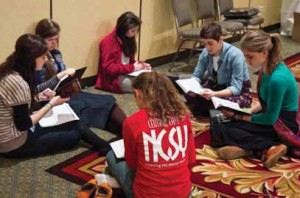A Beit Midrash Like No Other
By Tuvia Fox
Growing up, I had a vague familiarity with NCSY as an organization my parents had been active in as teenagers. However, having had the privilege of being raised in a vibrant Orthodox community and to attend a “black-hat” yeshivah, NCSY was not an organization with much relevance to me.
Fast-forward the better part of a decade. My life progressed along a fairly predictable trajectory. I spent a number of years in yeshivah and several in Israel, and began working toward semichah and a degree in computers. Several years ago, I had the opportunity to participate in a fledgling local NCSY learning program that pairs public school students with learning partners for weekly Torah study. What began as a way to expand beyond the self-centeredness that personal education tends to engender gradually evolved into my becoming an NCSY regular, frequently attending regional Shabbatonim and other local events. Having the opportunity to shatter stereotypes—mine and theirs—about the disaffected American teenager and the Orthodox world, respectively, was both refreshing and mind-opening—a worthy supplement to my daily fare of intense Torah study.
This past winter break, 220 public school students from around the country gathered in Stamford, Connecticut to attend NCSY’s annual weeklong National Yarchei Kallah. While the purpose of Shabbatonim is “to open Jewish doors,” inspiring NCSYers with the spirit of Yiddishkeit interspersed with a generous dose of fun, Yarchei Kallah has an additional, more defined focus.
The organizing force behind Yarchei Kallah is Rabbi Yaakov Glasser, NCSY’s national director of education and the New Jersey regional director of NCSY. He expressed to us the lofty goal of the weeklong learning program—to expose public school students to Judaism’s ultimate driving force, Torah study, and inspire them to make Yiddishkeit a more central part of their lives.
I was offered the opportunity to attend, and after some brief deliberation (it was winter break for public schools, not for me), decided that this was an occasion I couldn’t miss. The program was centered around giving NCSYers a taste of a range of study styles—from advisor-led textual chaburot to shiurim from expert educators to a shiur klali for all the participants.

A group of public school students at this past NCSY’s National Yarchei Kallah in Stamford, Connecticut.
Photo: Kruter Photography/Kruter.com
On Thursday night, after a day full of Torah study capped by an energetic Maccabeats concert, many of the NCSYers opted to participate in some extra “mishmar”-style learning (complete with the requisite kugel and cholent). The Hilton’s Grand Ballroom was transformed into a pulsing beit midrash that could take pride of place among the batei midrash of our finest yeshivot. As the students concluded their learning for the night, they formed a circle in the lobby, and soon an impromptu kumzits was underway.
With the kol Torah in one ear and uplifting kol shirah in the other, one could truly sense the Jewish flame burning strong in each of the NCSYers. Here sat a boy from Pittsburgh who walks three miles to shul every Shabbat; there a girl from New York who made the decision to be shomer negiah in her public school; across the room a pair of boys who stayed up until the wee hours of the morning discovering the timeless Iggeret HaRamban.
Earlier in the day, one of the sessions, a “devar Torah workshop,” involved learning a number of sources, ranging from Chumash to Maharal. Small chaburot of NCSYers worked on constructing divrei Torah of their own. The final source was a Gemara: “I have learned much from my teachers . . . but from my students most of all.”
At the conclusion of the workshop, as dozens of NCSYers from across the country presented their original divrei Torah to the audience, sometimes intertwined with stories of their own journeys toward greater observance, I was riveted to my seat. True inspiration lies in Torah study, and NCSY’s National Yarchei Kallah had provided the perfect environment. Indeed, “from my students most of all.”
